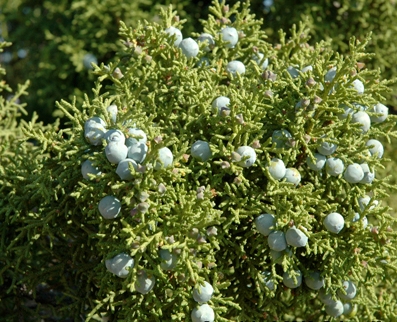Products

Juniper

- Botanical Name: Juniperus communis L.
- Family: Cupressaceae
- Flowering and fruiting: April-May
- Parts Used: Leaves and berries.
- Distribution: The plants prefer drier areas and abundant in central and eastern Nepal at an altitude ranging between 1800-3600m, Himalaya (Kashmir to Bhutan), Afghanistan.
- Method of Extraction: steam distillation of needles and young twings of Juniperus communis L.
Description:
A dense erect shrub to 1.5m or at high altitude a prostrate shrub. Leaves needle-like sharp-pointed, 6-13mm long, with a broad bluish, white band above, in whorls of 3. Male cones ovoid, recalling leaf buds; female cone blue-black when ripe.
| Specification of Juniper | |
| 1. Organoleptic Properties | |
| Appearance | Mobile liquid. |
| Color | Water white or pale yellow |
| Aroma | Rich-balsamic, woody-sweet and pine needle like odor. |
| 2. Physico-chemical Properties | |
| Specific gravity | 0.8563 to 0.8731 at 23°C. |
| Optical rotation | [-] 22º to [-] 41.7º at 23º C |
| Refractive index | 1.481 to 1.899 at 23°C |
| Acid number | 0.5 to 2.5 |
| Ester number | 3.06 to 20 |
| Ester number after acetylation | 40 to 65 |
| Solubility | Some oils are soluble in 95% alcohol and some are not. |
| 3. Chemical constituent: | |
| ά- pinene, sabinene and ά- terpinene as major components and others are camphene, β- pinene, δ-3-carene, myrcene, limonene, β-phellandrene, γ-terpinene, p-cymene, terpinolene, trans-3-ethoxy-p-menth-1-ene, campholenic aldehyde, camphor, ά-copaene, bornyl acetate, terpinen-4-ol, caryophyllene, ά-terpineol. | |
| 4. Uses | |
|
|
